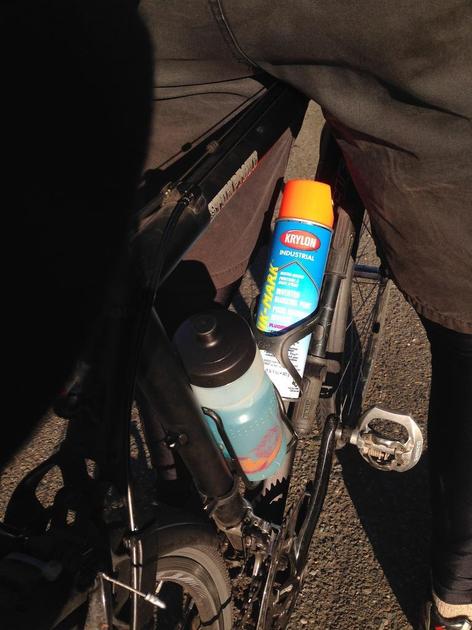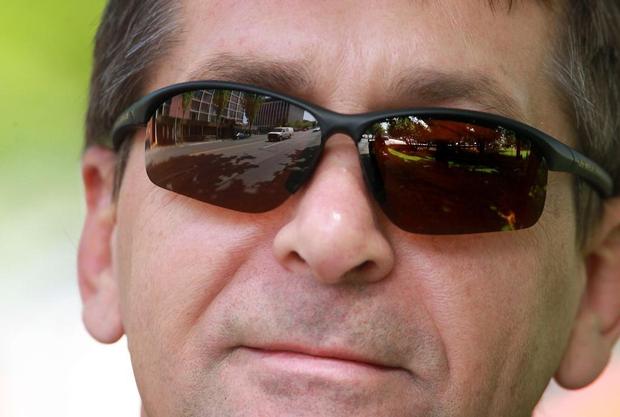The complete article and photos is available at http://www.thenewstribune.com/...thon-goes-extra.html
I pasted the text below.
Enjoy. -- Justin
+++++
Capital City Marathon goes extra mile so runners don’t have to
BY CRAIG HILL, Staff writer
May 9, 2015
Read more here: http://www.thenewstribune.com/...a.html#storylink=cpy
As I parked along Capitol Way at 7 a.m., Nov. 15, I tapped my car’s temperature display with my index finger.
It said 19 degrees, and I was hoping it was wrong. It didn’t change. I sighed and started pulling on layers of clothes.

I was here to meet running course measurer and certifier Lee Barrett, Capital City Marathon president Jim Lux and City of Olympia planner Steve Friddle. The men were spending the weekend measuring the Capital City Marathon, half marathon and 5-mile courses.
Technically speaking, none of us needed to be there. The course certifications weren’t due to expire for another year.
However, the race’s attention to detail had been called into question — albeit by just two men — and race officials weren’t going to wait (no matter the temperature) any longer to squash the talk.
Last spring, Gary Cooper and Bob Brennand of Olympia contended the marathon course was 393 feet longer than the traditional 26.2 miles.

Gripes about courses distances have become much more common in recent years thanks to the widespread availability of GPS-enabled phones and other devices. Typically, race officials try to explain why these devices aren’t likely to match up with the course.
The complaints from Cooper and Brennand could have been shrugged off, too, but Cooper and Brennand aren’t your typical weekend warriors. Cooper won the Capital City Marathon in 1996 and set the “super masters” course record in 2012. Brennand is fast, too. Fastest of the 113 South Sound residents in the 2014 Boston Marathon.
Brennand also measures courses. He’s measured 42 USA Track and Field certified courses between Tenino and Maple Valley.
So when they complained, the Capital City Marathon organizers said they listened. They also stood by their certification with both Lux and race director Nona Snell saying the course was 26.2 miles.

But, already interested in tweaking the course, race officials decided to make the changes and certify the course a year early.
And when it came to measuring the new course, race officials went the extra mile so participants didn’t feel as if they’d have to.
MEASURE OF EXPERIENCE
They scoured the Northwest for a measurer with impeccable credentials, then invited Cooper, Brennand and the media to come along for the measuring process.
And that’s why I was standing across the street from Sylvester Park that frigid Saturday morning, watching Barrett tinker with my new bike. He was adding a device called a Jones counter to my front wheel.
My measurement wouldn’t be used. Barrett’s and Friddle’s were official. But Barrett, a former journalist, wanted to make sure I had a hands-on experience.

Races typically pay $35-$50 per mile to have the courses measured, on top of a $30 certification fee. Capital City paid more for Barrett, in part because they brought him in from Portland.
Courses measurers are independent contractors. In fact, anybody can measure a course and submit it to USATF for certification. Barrett is the USATF certifier for Oregon.
He’s also one of an estimated 20 measurers in the United States to have the International Association of Athletics Federation’s highest level of certification. This means he can measure courses for major international events, such as the Olympics.
I was following along as he measured the half-marathon course. The next morning, Brennand and Cooper joined him to measure the marathon course.
The men left confident the marathon course is accurate. But because the course changed, this does not confirm the old course was accurate. Brennand and Cooper still believe it was long. Marathon officials still disagree.
GETTING CALIBRATED
Before we started riding the course, we biked over to East Bay Drive, where a 300-meter-long calibration course is set up on the shoulder of the road.
Here Barrett recorded the numbers displayed on the Jones counters at the start and finish of the course. We rode the course four times each. All of the measurements needed to be within 0.1 percent of each other before we were ready to ride the course.
From here, we headed back to the Governor Hotel lobby so Barrett could crunch numbers and we could warm up. Then we were ready to ride the course.
Both Barrett’s and Friddle’s measurements would have to fall within the safety margin of 0.1 percent (a difference of 2.1 meters) or they’d have to start over.

DUCKS AND BIRDS
Because the marathon officials want all the races to finish in the same spot near Sylvester Park, we rode the course backward.
Measuring the course isn’t as simple as just biking the roads.
Barrett stopped at each mile, recording the numbers from the Jones counters and marking the point on the road with orange spray paint. This means it takes longer to bike the course (2 hours, 11 minutes in our case) than many runners will need.
I found the ride to be nerve-racking at times, and not just because one mistake meant starting over.
For the most accurate distance, we had to ride the route in the manner the runners would run it. This means taking direct lines between turns rather than staying on the edge of the street. It also means sometimes riding on the wrong side of the road.
None of this would be so bad if the roads were closed as they are on race day. But they aren’t.
We wore bright yellow vests with the words “Official Measurer” on the back, but we must have looked like the world’s most inept bike club as we rolled around Olympia.

Some drivers honked. Some shook their heads and flashed their headlights. And a grandfatherly gentleman passing in a pickup seemed to be sharing with us his passion for ornithology (he flipped us a bird and mouthed something about a duck).
None of this fazed Barrett. He was so intent on taking the right line, at some points he unclipped from his pedals and rolled his bike through piles of leaves accumulated on the side of the road.
When parked cars blocked the way, he didn’t simply swerve around them. He dismounted, locked his front wheel in place so it wouldn’t move the counter, and then moved far enough toward the middle of the street to pass the car. Once passed, he dismounted, unlocked the wheel and returned to his line.
GPS SHORTCOMINGS
While experienced runners are likely to take the most direct path, inexperienced runners are not. And this is why many will look at their GPS units after the race and wonder why it says they went farther than the advertised race distance.
“I tell people if your GPS says you ran farther, you probably did,” Barrett said.
But not necessarily. The GPS-enabled running app on your phone isn’t always perfect. Sometimes it’s just close.
For example, when I used a popular app on my phone during our calibration ride, the map it generated indicated I’d zig-zagged my way up and down East Bay Drive, rolled through a few people’s front yards and went off-roading in a greenbelt.
I’d never left the road’s shoulder.

The old-fashioned Jones counter doesn’t have these issues.
The evening after our ride, Barrett emailed me the results from the half marathon measurement.
They both needed to be within 2.1 meters of the official half marathon distance, 21,097.5 meters.
Barrett’s measurement: 21,097.43 meters.
Friddle: 21,097.67 meters.
How’s that for accurate? A 13.1-mile course, and their measurements differed by less than the length of a size 6 men’s running shoe.
Craig Hill: 253-597-8497 craig.hill@thenewstribune.com @AdventureGuys
# # #
